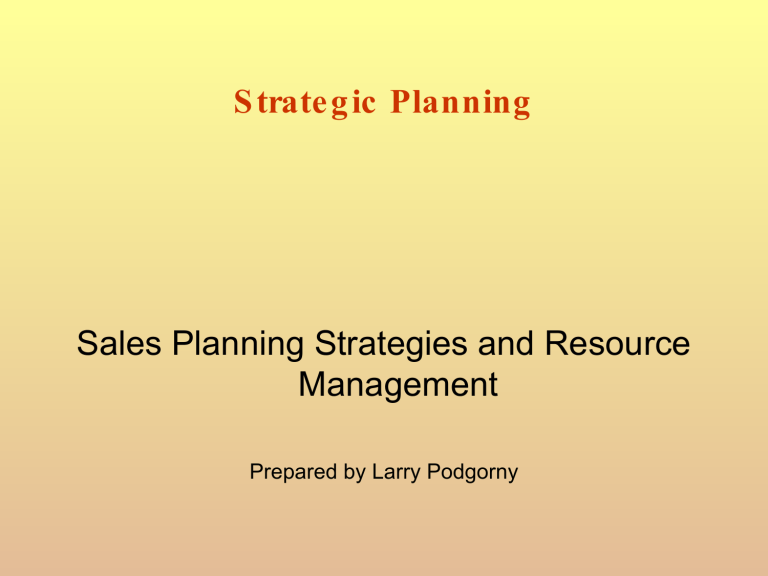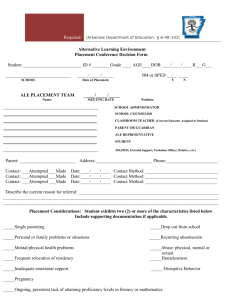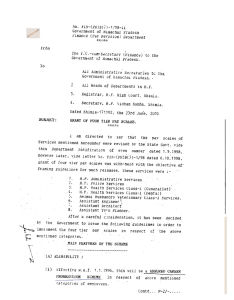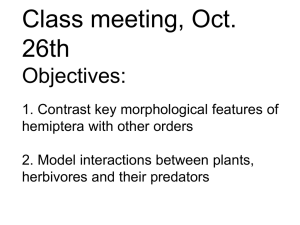
S trate g ic Planning Sales Planning Strategies and Resource Management Prepared by Larry Podgorny Why Plan ? Alice: Which way should I go? Cheshire Cat: That depends on where you are going. Alice: I don’t know where I am going. Cheshire Cat: Then it doesn’t matter which way you go!! Lewis Carroll 1872 Through the LookingGlass The Plan • • • • • In the beginning was the plan. And then came the assumptions. And the assumptions were with out form. And the plan was completely without substance. And darkness was upon the face of the workers. De finitio n o f S trate g y /S trate g ic • A careful plan or method • The art of devising or employing plans or stratagems toward a goal • Of great importance within an integrated whole or to a planned effect • Necessary to or important in the initiation, conduct, or completion of a strategic plan What S trate g ic Planning is No t • Strategic planning is not forecasting • Strategic planning is not the simple application of quantitative techniques to business planning. • Strategic planning is concerned with making decisions today that will affect the organization (product line) and it’s future. • Strategic planning does not eliminate risk, it helps managers access the risks they must take by gaining a better understanding of the parameters involved in their decisions. S implifie d Pro c e s s o f S trate g ic Planning The process of strategic planning is a step-by-step approach three key questions that lie at the heart of any business strategy: • What are you going to sell? • Who are your target customers? • How can you beat or avoid your competition? If you can answer these three questions well, you have a strategy. S implifie d Pro c e s s o f S trate g ic Planning (Co nt.) • There’s no denying that a simplified process involves complex issues. • The process involves digesting a lot of information and requires some fairly difficult analysis. • Good strategic planning should be simplified not simplistic. • Good intentions alone does not get the job done. S implifie d Pro c e s s o f S trate g ic Planning (Co nt.) • You need to see it big at first. Start at a high level. • Sift through all of the noise to get to the important details • The next step is do the things that matter very well. • Occasionally, go back up to the high level to make sure everything is still on course. S implifie d Pro c e s s Of S trate g ic Planning - S tart By S tudying The Way It Is No w • You need to gather basic information and facts without making any judgments. • Based on this information you build some assumptions, again without making judgments. • This process is the central part of the planning process and needs to be reviewed in detail because this information is the foundation for all further strategy discussions and decisions. 2. 3. 4. Data External Situation Internal Situation Capabilities and competencies 2. Analysis 7. Strategic assessment Strategic Issues 6. 2. 2. 3. 4. Direction Strategies Commitment Mission Statement Goals Objectives Implementation Action Plans Budgets Schedules Ideas Assumptions S implifie d Pro c e s s o f S trate g ic Planning - Ho w it Wo rks Planning •Gather Information •Assess Capabilities •Make Assumptions •Make Strategic Assessments •Formulate Strategy •Establish Goals and Objectives •Formulate Tentative Action Plans •Finalize Action Plans Monitor Developments and Progress Execution Total Organizational Planning Strategic Planning Marketing Information Long Term Business Plan Market Plan Shorter Term Business Plan Sales Plan Key Account Strategy Target Account Strategy Maintenance Account Strategy Why Bother Account Strategy Strategic Territory Plans Key and Target Account Plans Action Plans Control & Evaluation Tactical S tart by S tudying the Way It Is No w The course to your vision, like all navigation, starts with a known position. • What markets should you pursue • Who are your competitors • Where is your competitive advantage • What are your strengths • What are your weaknesses Figuring out point A is the first essential step to charting a course to get to point B. So get your bearings! Where are you today? P O S I T I O N I N G Which segments / customers will we concentrate on ? CUSTOMER TARGETS Whom will we challenge for these customers? COMPETITOR TARGETS What incentives will we provide to get them to buy from us… rather than from competitors? CORE STRATEGY DEFINING AND S ELECTING KEY/TARGET ACCOUNTS Strong Weak High • • • • • ACCOUNT ATTRACTIVENE SS Size Growth Profitability Location Purchasing criteria and processes • Current suppliers • Status of customer (prestige) Low Invest / Grow Maintain Selectively Invest Manage for Cash / Withdraw BUSINESS STRENGTHS • Product range • Product efficacy (the power to produce an effect ) • Service quality (inc. distribution) • Price • Associated services (e.g. Tech advice) • Reputation/image • Past experience • Quality of sales staff ACCOUNT PORTFOLIO ANALYS IS High Account Opportunity Low Weak Strength of Position Strong KEY TARGET Attractiveness: Accounts are very attractive since they offer high opportunity and sales organization has strong position. Attractiveness: Accounts are potentially attractive since they offer high opportunity, but sales organization currently has weak position with accounts. Sales call strategy: Accounts should receive a high level of sales calls since they are the sales organization’s most attractive accounts. Sales call strategy: Selected accounts should receive a high level of sales calls to strengthen the sales organizations position. MAINTENANCE WHY BOTHER Attractiveness: Accounts are somewhat attractive since sales organization has strong position, but future opportunity is limited. Attractiveness: Accounts are very unattractive since they offer low opportunity and sales organization has weak position. Sales call strategy: Accounts should receive a moderate level of sales calls to maintain the current strength of the sales organization’s position. And, efforts should be made to replace field sales calls with telephone sales. Sales call strategy: Accounts should receive no field sales calls and a minimum of inside sales resources. ACCOUNT S EGMENTATION AND PRIORITIZATION High KEY ACCOUNTS TARGET ACCOUNTS ACCOUNT ATTRACTIVENESS (Your competition’s Key Accounts) • 10-20% of your account base • Gets very little attention • 80% of your GP$ • Receives less than 50% of your resources MAINTENANCE ACCOUNTS • 40-45% of your account base • 10-15% of your GP$ • Receives 30-40% of your resources Low Strong WHY BOTHER? ACCOUNTS • 30-40% of your account base • Less than 5% of your GP$ • Receives 20-30% of your resources • Creates 90% of your “headaches” YOUR STRENGTH OF POSITION Weak Strong S ale s Te am and S e lling Effo rt Sales Channel: Major Account PROGRAMS KEY Sales Channel: Selling Effort: Field Selling and Inside Sales Sales Channel: Direct Marketing, Teleselling, and Field Selling Selling Effort: Heavy MAINTENANCE Heavy (best prospects) Low (other prospects) WHY BOTHER Sales Channel: Inside Sales Field Selling and Teleselling Sales Channel: Teleselling, Direct Marketing, and Some Inside Selling Effort: Moderate Selling Effort: Low Weak ACCOUNT OPPORTUNITY Selling Effort: Heavy by Specialist TARGET Strong COMPETITIVE POSITION Weak Changing Business Environment The Selling Ballgame Leads to Changing Selling Environment Resulting in Harder to Get and Hold Customers and It Costs More! Implications ☛ Better Understanding of Customer’s Needs ☛ Better Selectivity ☛ Better Selling Strategies ☛ Better Time & Territory Management PRIORITIES Time Management Your Scarcest Resource TOTAL BUSINESS DAYS 2002 Less: • Vacation • Holidays • Personal absences WORKING DAYS AVAILABLE IN YEAR Less: • Meetings, Trade Shows, etc. • Training • Customer unavailability • Miscellaneous TOTAL 252 10 10 5 25 227 Acct. Service/ Coordination 13% Travel 17% 2001 Face-to-Face Selling 29% HOW S ALES PEOPLE S PEND THEIR TIME Administration 16% Phone Selling 25% Acct. Service/ Coordination 11% Travel 18% 2000 Face-to-Face Selling 30% Administration 16% Phone Selling 25% The Co nte mpo rary Marke ting Co nc e pt Customer Orientation The purpose of a business is to satisfy the needs of customers. Products and services are important only to the extent that they satisfy these needs—they are means rather than ends. Therefore, marketing starts with the determination of customer needs and ends with the repeated satisfaction of those needs. Profit Orientation A business must satisfy the needs of its customers at an acceptable level of profitability. Therefore, the purpose of marketing is not simply to generate sales or achieve a certain market share, but rather to produce profitable sales and a profitable market share. Integrated Effort All activities or a business should be integrated and coordinated so as to satisfy customer needs at a satisfactory rate of profitability. Marketing must be coordinated with finance, production, personnel administration, engineering, and research and development. Moreover, all marketing activities must be effectively integrated and coordinated in order to achieve market impact. I. Cus to me r Chang e Drive rs • Raw material shortages • Regulatory agencies • Environmental • Global competition • Trade agreements (NAFTA, GATT) • Mergers/acquisitions • Automation/technology • Reduction in cycle time • “Price” • “Quality” • Down sizing Cus to me r Chang e Drive rs (c o nt’d .) • Reengineering • Out-sourcing • Systems versus products • Out-sourcing of engineering and R&D to vendors • Long term contracts (5 years) • Sharing of warranty costs by suppliers • EDI • Vendor reduction II. Purc has ing Be havio r/Buying Re latio ns hips • Manage supply channel • – strategic alliances • – partnering • – customer linked strategies • – integrated supply • National account programs • Single source • – product breadth • – product depth • EDI • • • – seamless order and delivery – automation – paperless • Removal / reduction in any redundancy • Vendor reduction Purc has ing Be havio r/Buying Re latio ns hips (cont’d.) • Broader offering of “true” value added services • Proof of performance—vendor score cards provided by vendors • Vendor as a business consultant to account • Problem solving vendors will be chosen • Reduction of in-house expertise by customers • Require modular / systems, global vendors with total quality • Purchase “packages” of integrated components (systems) versus single components • Better P.O.P. merchandising III. Ro le o f the S ale s Te am • • • • • • • Increased speed of response Technical value-added sales calls Greater knowledge of customer, competition and sellers company Ability to make decisions (empowerment) Relationship selling at higher level—sell the “whole” customer Empathy for the customer Functional sellers • – sales teams/sellers focused on opening accounts through “selling” creative solutions to problems • – account managers on accounts to “service” IV. S ale s Fo rc e Is s ue s / Pro ble ms • • • • • • • • • • Willingness to change Different organizational structure, e.g., Hunters and Farmers New skills Sales force automation Accountability / evaluation / compensation More specialized sellers required—currently generalists Total company will become a selling team—cultural change Shift paradigm from products to integrated solution systems More research at the account level Sharing of customer information V. Chang e Are as • International, national account perspectives • Better technical skills • Better research skills • “Understanding” • Customer specialized sales forces Why Do Sales Organizations Become Obsolete? Growth Evolution I II III IV Any business is good! All Business is good! What business is good? Certain business is good! One product One market One product One big market Old/new products many markets Redefine customer segment selling Sell to survive Sell volume to lower costs Sell volume to hold share Optimize to get best returns Start-up Volume growth Market share Optimization THE PURPOS E S ALES FORCE TIME & EFFORT Customer Resource Allocation Decisions Product Resource Allocation Decisions Activity Resource Allocation Decisions What segment(s) to call on New vs. existing products Hunting vs. farming What volume segments to call on: High volume vs. low volume products Selling vs. servicing Easy to sell vs. hard to sell products – High volume vs. low volume – Familiar vs. unfamiliar products Relationship expert vs. product expert vs. industry expert vs. customer expert – National accounts vs. smaller accounts What profitability segments to call on: highly profitable vs. less profitable New vs. existing accounts High penetration vs. low penetration accounts What geography to focus on Headquarters vs. field calls – Products with high short-term impact and low carryovers vs. products with low short-term impact and high carryover – High-tech products vs. low -tech products – Long selling cycle vs. short selling cycle – Differentiated vs. non-differentiated – Highly competitive vs. noncompetitive S ELLING PROCES S ES Where buyers experience the greatest challenges EVOLUTION OF BUYING PROCES S Selling organizations get involved at different stages in the customer’s buying process Planning 1 Recognizing Searching 2 3 Evaluating Selecting 4 5 Committing Implementing Tracking 6 7 8 VENDOR “Present-Handle Objections-Close” SUPPLIER Searching through implementing ADDED VALUE PARTNER Entire process: Planning through tracking results Where Sellers Focus Efforts S e lle rs Bo undary Ro le Communication Selling Organization Communication REP Buying Organization Marketing Strategy Procurement Strategy policies procedures programs policies procedures programs Trans ac tio ns and Re latio ns hips Transaction Selling Relationship Creation 1. Selling dominates learning 1. Learning about the customer is intense and dominates selling 2. Talking dominates listening 2. Listening dominates talking 3. Persuading the customer is product driven and benefits focused 3. Teaching the customer is need driven and problem focused 4. The goal is to build buyers and sales through persuasion, price, presence and terms 4. The goal is to build relationships through credibility, responsiveness, and trust TYPICAL PROCES S Recognition of Needs Help customers recognize and define problems and needs in a new or different way. Evaluation of Options Show superior solutions, options, and approaches that customers may not have understood or considered. Resolution of Concerns Help customers overcome and remove obstacles to acquisition. Purchase Make purchase painless, convenient , and hasslefree. Implement station Show customers how to install and use product. ADDING VALUE TO A TRANS ACTIONAL S ALE Recognition of Needs Evaluation of Options Resolution of Concerns Customer has already defined needs and problems completely . Customer already understands alternative solutions. Custome r has few issues or concerns . Little or no opportunity to create sales value. Little or no opportunity to create sales value. Little or no opportunity to create sales value. Purchase Seller can help make purchase painless, convenient , and hasslefree. Little or no opportunity to create sales value. Implementstation Customer generally knows how to use product. ADDING VALUE TO A CONS ULTATIVE S ALE Recognition of Needs Seller can create most value early in the process by helping customers define needs and solutions. Evaluation of Options Resolution of Concerns Consultativ e seller can design customized solutions and help customers make informed choices. Consultativ e seller can counsel customers and help resolve concerns. Purchase Implemen t-tation Consultativ e seller can advise and problem solve implementa tion issues. S ale s Call Time TYPICAL SALESPEOPLE KEY ACCOUNT SALESPEOPLE 5% Needs Analysis 50% 10% Problem Solving 30% 35% F/B. Presentation 15% 50% Trying to Close 5% Buying Dis c ipline in Trans itio n • Tactical Purchasing Strategic Sourcing • Regional Focus Global Focus • Large Supplier Base Strategic Partners • Commodity Purchases Technology Investments • Product Focus Solution Focus • Buying Parts Managing Processes • Price Focus Total Cost / Value Re s e arc h Finding s • The world of selling is dynamic by customers’ changing needs and values. • Customers are more reliant upon sellers for: – information – advice – problem solving • Information technology is having a major impact on customer / seller relationships. • Total organization win, sustain, and grow customer relationships. Implic atio ns fo r S ale s pe o ple •Salespeople need to understand how to: • Respond to the needs customers have for information, advice and problem solving. • Create value beyond their products and services in a way that differentiates the selling organization from its competition. • Create and manage the organization-toorganization relationship. S ale s Dis c ipline fo r the 90’s How you can… Thinking Strategically Anticipate ways to create value for customers Managing Information Deliver focused, usable information to customers and associates Advancing the Relationship Increase customers’ trust in and commitment to you and your company Orchestrating Resources Form an efficient sales team and manage it costeffectively Ke y S hift— S e lling Co mpe te nc ie s NOW Strategic Selling FUTURE Strategic Selling “World Class” • Work Processes – Systems Transactional Selling • Information Flow Transactional Selling “Bo tto m Line ” A business can no longer rely on the uniqueness of their products to retain customers or grow new sales revenue. Customers will align their business with strategic suppliers who understand their business and bring a unique offering which adds value— impacts their “bottom line” through increased sales revenue or reduced costs Natural S ale s S kills 5% 35% 60% 5% “Process the requisite selling skills that make them stand out” 35% “Just manage to pay their way” 60% “Just there for the beer” ✔ Super Salesperson’s Characteristics • • • • • Charisma in sales situation Sense of humor Good planning and preparation skills Physical energy Tenacity and resilience at rejection Peak Sales Performers Study of 1,500 Achievers Over 20 years • Take risks and innovate • Powerful sense of mission • More interested in problem solving • See customers as partners • Rejection is information • Use mental rehearsal THE S ALES PERS ON OF TODAY IS EXPECTED TO: • • Do more forecasting of future customer requirements • Spend more time planning calls • Spend more time in group, system, and strategic selling • Improve territory management • • • • Do less driving in the territory Spend more time in telephone selling Do more “active” selling Prepare more detailed market reports PROFITS The Ke y Challe ng e Sales Productivity Where: = G.M. = C.O.S. = G.M. C.O.S. Gross Margin Dollars Cost of Sale in Dollars Implications 1. Less discounting. 2. Selling higher margin products. 3. Selling more product lines to each customer (cross-setting). 4. Being more selective and discriminating in qualifying potential buyers. 5. Better use of selling time (deployment). S ALES FORCE PRODUCTIVITY 1st Effectiveness Clear priorities in terms of: • Markets • Customers • Products • Activities And clear strategy To drive the allocation of resources + 2nd Efficiency Managing the allocation of sales resources to: • Markets • Customers • Products • Activities Measure the "return on investment" regularly. = Productivity Components of Sales Productivity PRODUCTIVITY EFFICIENCY EFFECTIVENESS Number of doors opened What is done once in door S UMMARY Sales Efficiency Sales Effectiveness Defined Getting in front of customer at minimum cost Using skills and abilities to maximize sales potential Mechanisms for improving Working harder: – time management – incentives – call reports – territory design Working smarter: – coaching – skills training – account strategies Measures – penetration – call rates – cost / call – success rates – repeat business – sustainable margins



